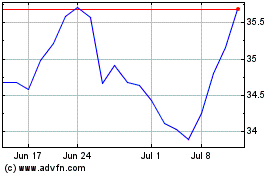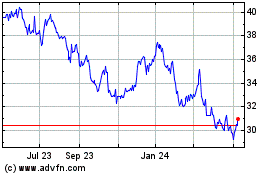CORRECT: Sanofi Needs To Avoid Pitfalls Of Past Pharma-Biotech Deals
February 17 2011 - 1:36PM
Dow Jones News
Sanofi-Aventis SA's (SNY) long courtship of Genzyme Corp. (GENZ)
has finally ended in an acquisition deal, but now comes the hard
part: making the marriage work.
The track record of large pharmaceutical companies purchasing
smaller biotechnology and specialty-drug makers is mixed. Buyers
tend to overvalue the acquired assets, and the talent that made the
acquiree attractive frequently depart to a new project.
Roche Holding AG (RHHBY) said it had tried to avoid those
pitfalls following its acquisition of full control of biotech
company Genentech in 2009 for $46.8 billion, but then it got hit by
another risk from these deals--unforeseen challenges.
In Sanofi's case, the company has taken some steps to mitigate
the risks in its planned purchase of Genzyme for at least $20.1
billion, unveiled earlier Wednesday. In addition to the cash
consideration, Genzyme shareholders will receive rights eligible
for future cash payments if Genzyme hits certain milestones, an
arrangement that addresses some of the speculative risk inherent in
drug development.
What's more, Genzyme is no baby biotech. It's a more mature
company that has had profitable drugs on the market for years. So
the company isn't making a big bet on unproven
research-and-development, as much as expanding its drug-making
operations.
"Biotechnology had never really been embraced by Sanofi-Aventis
in the past, and I think that proved to be a weakness of the
company," Sanofi Chief Executive Christopher Viehbacher said
Wednesday.
But there are always risks in such combinations that Viehbacher
will have to carefully navigate. Aside from the potential for drug
setbacks, the slow-moving hierarchies at big drug makers can chase
off talented executives and scientists at the smaller companies
they snatch up, undercutting the future potential of the acquired
assets.
"There's a tendency to overpay," said Morningstar analyst Damien
Conover. "The innovative spirit of the entrepreneurial nature of
biotech, that tends to be the hardest thing you can keep."
Roche Chief Executive Severin Schwan said in a recent interview
that Roche has for the most part tried to leave Genentech's R&D
labs alone.
"Innovation and science need a decentralized management
approach," he said. "In research and development, it is not a
matter of scale. I would rather have a bit of duplication at the
centers in the world, than lose productivity."
Roche did streamline administrative, financial and back-office
functions immediately--including scaling back an operation in
Nutley, N.J.--but Schwan said the company has been successful in
retaining scientists and researchers because the culture hasn't
changed. He said he believes that many companies approach
integrations by using accountants and spreadsheets to squeeze out
savings, something that forces an internal focus and distraction
among workers.
"If you think that you have to align everything around the
globe, that everybody has to do it along one recipe, then you kill
innovation. That is the beginning of the end," he said.
However, the Roche-Genentech deal also illustrates the risk that
acquired products can encounter, namely challenges that may not
have been fully apparent at the time of the transaction. Sales
growth for Roche's Avastin cancer drug, which was developed by
Genentech, are now seen slowing partly because of U.S. regulatory
scrutiny of its effectiveness.
"I think the big concern with integrating any deal like this is
the larger company not absorbing the culture of the smaller
companies," said Christopher Bowe, a health-care analyst with
research and publishing firm Informa.
"There's a tendency for the acquiring company to come in with an
attitude that it probably knows best," Bowe said. Big companies
need to be more open to adapting the best practices of the acquired
company, especially in making research labs more productive, he
said.
When deals between large pharmaceuticals and smaller biotechs
pay off, the upside is often so big that it offsets the failed
deals. As a result, big drug makers--especially those facing
patent-expiration challenges like Sanofi--are often willing to
continue to shell out big bucks.
Johnson & Johnson's (JNJ) $5 billion purchase of Centocor in
1999 succeeded because Centocor's Remicade anti-inflammatory drug
went on to become a blockbuster and J&J inherited talented
personnel. But the jury is still out on whether AstraZeneca PLC's
(AZN) 2007 purchase of MedImmune was worth its $14 billion price
tag, as the acquired products haven't provided a big lift to
overall financial performance.
AstraZeneca, in an emailed statement, called the MedImmune buy
"a long-term strategic investment" and noted that the "product
development timeline in our industry is long and relatively
unpredictable." The company touted MedImmune's research expertise
in biotechnology-style drugs.
Eli Lilly & Co. (LLY) bought ImClone Systems in 2008 for
$6.5 billion on hopes for continued sales growth for cancer drug
Erbitux, as well as the expectation that one or more of ImClone's
experimental drugs would reach the market and have commercial
success.
But Erbitux sales have slowed after the discovery that it wasn't
effective in people with a certain genetic profile, and Lilly and
partner Bristol-Myers Squibb Co. (BMY) recently halted a late-stage
trial of experimental cancer drug necitumumab because of safety
concerns. Another late-stage trial for the drug continues.
-Peter Loftus, Dow Jones Newswires; +1-215-656-8289;
peter.loftus@dowjones.com
--Thomas Gryta contributed to this article.
Roche (QX) (USOTC:RHHBY)
Historical Stock Chart
From Apr 2024 to May 2024

Roche (QX) (USOTC:RHHBY)
Historical Stock Chart
From May 2023 to May 2024
